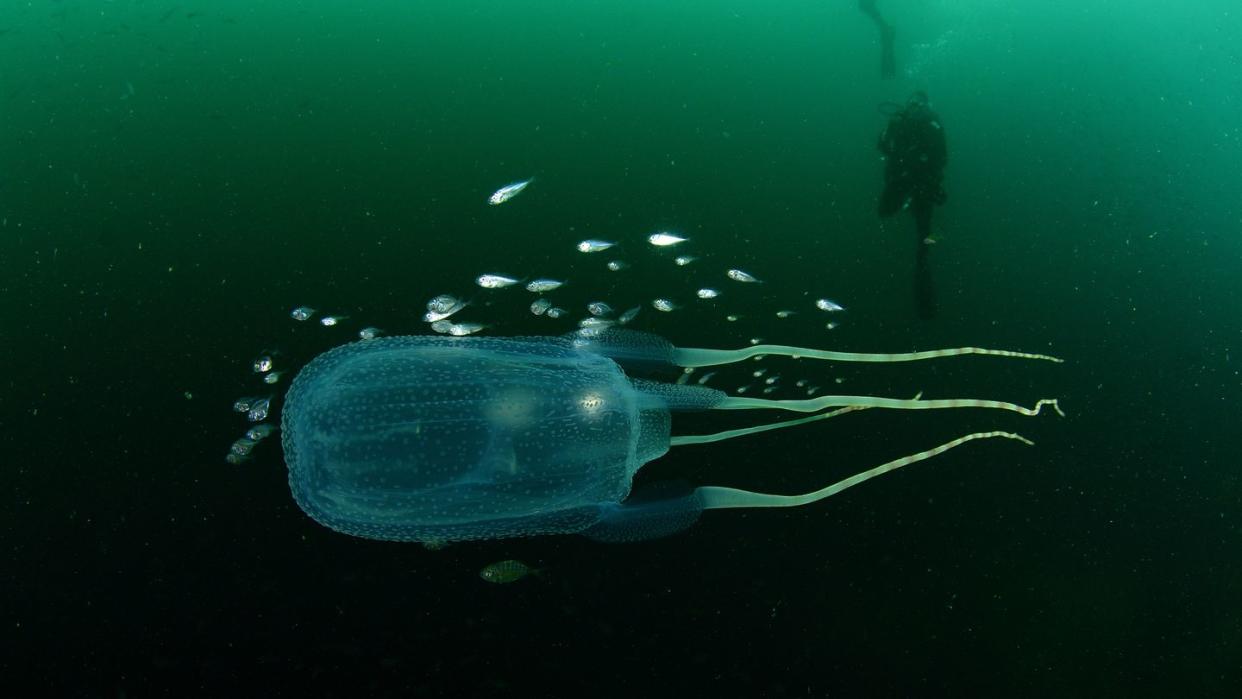These Deadly Jellyfish Could Help Us Understand Our Own Brains

Researchers have seen for the first time that jellyfish can learn in a complex manner, and adapt their behavior based on that learning.
Jellyfish have no brains and only about 1,000 neurons, but they are apparently able to learn things through trial and error about as fast as a mouse.
Now, the hunt is on to figure out exactly how they do this, and what it can teach us about our own brains.
We all have a pretty good understanding of what jellyfish are, right? Squishy, gelatinous, occasionally painful and even more occasionally deadly blobs that just sort of float around in the sea aimlessly? Not a thought in their non-existent brains?
Well, while we aren’t wrong about the squishy, floaty, or occasionally deadly parts, it turns out that we were in fact wrong about the “not a thought” parts. Because according to a new study published in the journal Current Biology, despite the fact that jellyfish do not have brains, and that their entire nervous systems are comprised of about 1,000 cells (compared to our own brains, which have about 100 billion), they can learn.
Yes, you heard that right. Jellyfish apparently have advanced learning capabilities. “It was once presumed that jellyfish can only manage the simplest forms of learning, including habituation – i.e., the ability to get used to a certain stimulation, such as a constant sound or constant touch,” Anders Garm, one of the researchers on the study, said in a press release. “Now, we see that jellyfish have a much more refined ability to learn, and that they can actually learn from their mistakes. And in doing so, modify their behavior.”
“For fundamental neuroscience, this is pretty big news. It provides a new perspective on what can be done with a simple nervous system,” Garm continued. “This suggests that advanced learning may have been one of the most important evolutionary benefits of the nervous system from the very beginning.”
Researchers took a look at the Caribbean box jellyfish, a jelly with a lethal sting that a press release referred to as a “fingernail-sized medusa,” to understand what these bags of neurons are truly capable of.
They noticed that, in the wild, individuals were employing a particular hunting strategy in and around mangrove trees. The roots of mangroves can be dangerous to the jellies’ fragile bodies, but they also make a good home for the jellyfishes’ favorite snack—plankton. So, the creatures needed to be able to get close enough to the mangroves without running into the roots.
It turns out that the jellyfish were able to judge—using their frankly over-numerous 24 eyes—how far away these roots were by seeing how sharply they contrasted with the water around around them. When the contrast was high enough, the jellies knew that they were too close and could dart to the side, avoiding the roots.
Now, contrast changes every day. On days where the water is super clear, for example, roots are going to appear in sharp contrast to the surrounding liquid from much further away. On murky days, the creatures will have to get a lot closer to the roots before the contrast really pops.
By recreating various murkiness conditions in the lab, researchers were able to see that the jellyfish learned every day exactly how close they could get to the roots before they needed to divert their course. According to the study, it took the jellies an average of 3-5 “failed evasions” where they bumped into a root to learn just how close they could get that day without a collision. Interestingly, Garm emphasized in a news release that this is about the same number of trial-and-error attempts that a mouse needs to learn something and adapt its behavior to suit.
And mice have the evolutionary advantage of having a brain.
Now that we know these creatures with their completely alien and wildly simply neurological makeup can truly learn and adapt their behavior, the search is on to figure out exactly how they manage the feat.
“We are now in the process of trying to pinpoint exactly which cells are involved in learning and memory formation,” Garm said in a press release.
“Understanding something as enigmatic and immensely complex as the brain is in itself an absolutely amazing thing,” he continued. “But there are unimaginably many useful possibilities. One major problem in the future will undoubtedly be various forms of dementia. I don’t claim that we are finding the cure for dementia, but if we can gain a better understanding of what memory is, which is a central problem in dementia, we may be able to lay a building block to better understand the disease and perhaps counteract it.”
Amazingly, it seems that one of the keys to better understanding our brains may just be a creature that has no brain at all.
You Might Also Like


